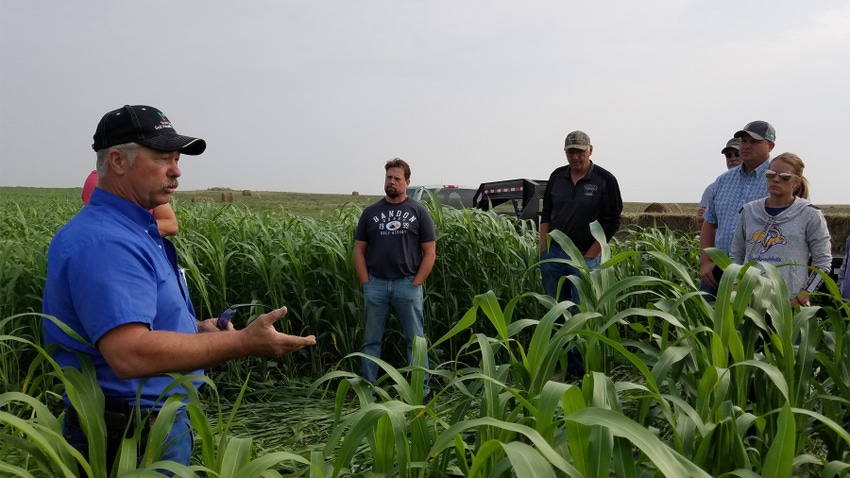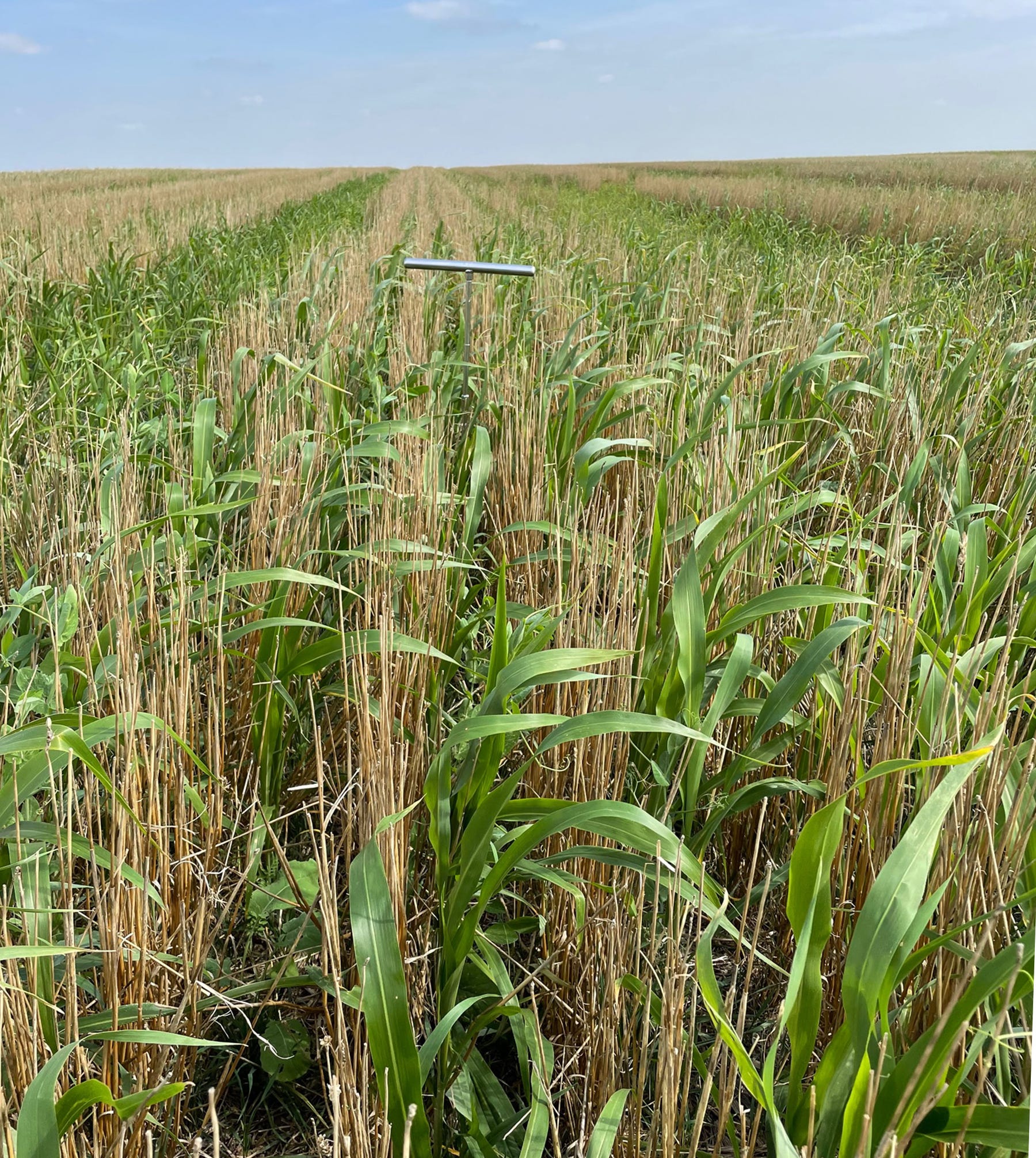August 1, 2023

Cover crops offer a range of potential benefits for producers — better nutrient cycling and soil structure, increased soil organic matter, healthier soil microbial communities, better weed suppression, and increased livestock forage.
To reap those benefits, producers need to make some careful decisions. These start with the goal for the cover crop. Is it intended primarily to produce forage for livestock, provide weed suppression or feed the soil?
Producers also need to know how much moisture will be available for the following cash crop. If a cover crop uses too much moisture, it can affect the yield of a water-sensitive crop like corn in the following season.
Monitor soil moisture
Dan Forgey, agronomy manager at Cronin Farms near Gettysburg, S.D., finalizes his cover crop decisions by determining how much moisture is available in the soil by arming himself with a soil probe.
“There’s a lot of people who say, ‘Plant them in dry dirt, and it’ll happen.’ I won’t do that because you want your covers to be a success,” Forgey says.
Cronin Farms has a diverse crop rotation and normally plants cover crops with higher carbon-to-nitrogen ratios for grazing after winter wheat harvest.
“When we planted our cover last year, it was after harvest. It was probably like the sixth or seventh of August that we planted it. And at that time with the soil probe, we had 16 inches of moisture in our profile,” Forgey says, which he thought was a bit dry.
The farm had received just enough rain that spring and summer to make a good crop, but it wasn’t enough to fully recharge the soil profile. Still, after some careful thought, the farm team planted the cover crops with hopes of 2 to 3 inches of rain.
At the time of cover crop planting, Forgey says the available moisture was at 86% of normal, so he reduced his seeding rate by a corresponding percentage. The goal was to reduce the number of plants taking up water in the field.
There was only one problem with his plan: Mother Nature had other ideas. They had rain in July, but no more precipitation until it snowed in winter. With that, the cover crop used that moisture quickly.
The cover crop wasn’t a total loss, but the true damage of last year’s dry fall won’t be known until this year’s corn is harvested. That’s when Forgey will really know if his cover crop decision paid off.
“The cattle grazed it, so we got some benefit out of it. But looking back, as dry as we are this year, it’s going to tell a story,” he says.
Flexibility and full season
While it’s true that cover crops planted after small grains carry a risk in dry conditions, their value comes with flexibility. Doug Sieck, a crops and livestock producer in Selby, S.D., planted cereal rye last fall after baling off some oats and peas.
“With rye, I plant that in the fall, so people will say, ‘What are you going to do with that?’ And I say to them, ‘I don’t know.’ And I really don’t,” Sieck says.
“When spring rolls around, I’ve got the option of grazing it and then plant something behind a grazing. Or maybe I’ll let it grow and plant green into it when it’s knee-high and then kill it. Or maybe I’ll cut it for hay like I am now. Or maybe I’ll let it go and combine it. And I’ve done all of those things, sometimes in the same year.”
Sieck, who is a South Dakota Soil Health Coalition board member, says planting a fall cover crop can be a gamble when it comes to moisture. “If your cover crop uses, let’s say, 3 inches of water, 90% of the time you’ll get enough moisture over the winter to replenish those 3 inches. Well, 10% of the time you don’t,” he says.
A few years ago, Sieck expressed his concern over having insufficient moisture to grow covers reliably to Jay Fuhrer, a Burleigh County, N.D., conservationist, who suggested Sieck dedicate a full season to growing covers.
“And so about then I switched mostly to full-season covers,” Sieck says.

PROBE TO KNOW: This cover crop at Cronin Farms near Gettysburg, S.D., was planted into heavy stubble on Aug. 12, 2022, at which time the field had 16 inches of soil moisture. The crop received no rain after planting, and when this photo was taken on Sept. 25, the field was so dry that it was difficult to push a soil probe into the ground, and growth on the cover crop had stalled. The yield of the corn crop planted this spring may be affected by the cover crop consuming the soil moisture. (Courtesy Cronin Farms)
Most of Sieck’s cover crops are a sudangrass mix of millet, turnips, radish, rapeseed, yellow blossom clover, and potentially other species planted in late June and used for fall forage. “As a guy who believes in a diverse rotation, I use the sudangrass mix for my diversity,” he says.
Forgey says full-season cover crops have their place, as in a prevented planting field.
“It had a tremendous amount of moisture in that field, and we just left it,” Forgey says. “And then we let the frost take it out, and the next year that was the best corn we had.”
Newell, S.D., producer Dave Ollila has his own cover crop strategy. He grows small grains for hay to feed his cattle and sheep, and he grows cover crops for forage and hay. In dry years, he will reduce the diversity and seeding rate of his cover crops, but he still plants them.
“For full season, it worked well for us to get them planted in May,” with grazing in June, Ollila says. “Sometimes if it’s dense enough and we were early enough, we’ll take a hay cutting to let them regrow, and then we’ll graze them later,” he says. “But our goal is to follow that cover crop with the winter annual. So, we’ll be terminating that cover crop somewhere in late August or early September and planting a winter annual.”
Fall nutrition
Ollila, who is a soil health specialist with the South Dakota Soil Health Coalition, says he also grows cover crops after harvesting his small grains for hay.
“The other way we use them is following a hay,” such as oats or wheat, “to have that living root and, hopefully, graze in October,” he says.
The reason he likes to graze cover crops in the fall is simple: nutrition.
Ollila often breeds ewes on the cover crops, whose nutritional value is between 17% and 22% protein. That is “ideal for that time of year when nothing else is at that level,” he says. “That’s perfect for breeding those ewes.”
Sieck says for a cover crop to be a success, producers need to understand the covers in their mix and how much moisture they will use.
“The guys around here that are that are doing things like covers, a lot of them are reliant on the agronomists at the co-op in town and saying, ‘Well, just fix me up with something.’ Well, that’s a sure recipe to grow a lot of forage out there and lose your moisture,” he says. “I’m a solid ‘yes’ on planting even if it’s dry, and I’m a solid ‘yes’ on planting the right thing out there.”
“Without a doubt, I believe in covers,” Forgey says. “All I’m saying is understand your system and understand how much moisture you’ve got when you plant your covers.”
Financial and technical assistance is available for producers interested in getting started with cover crops. To learn more, visit sdsoilhealthcoalition.org, or contact the South Dakota Soil Health Coalition at 605-280-4190 or [email protected].
Source: South Dakota Soil Health Coalition
You May Also Like




